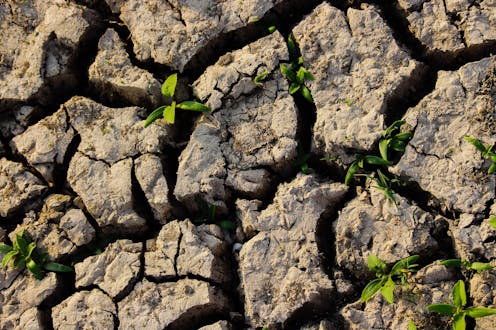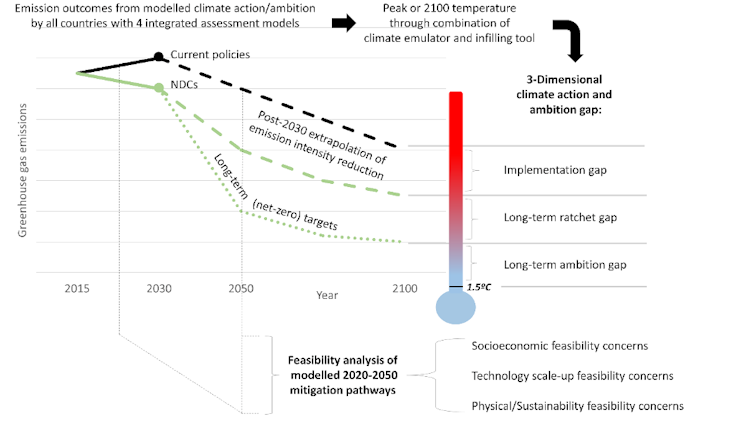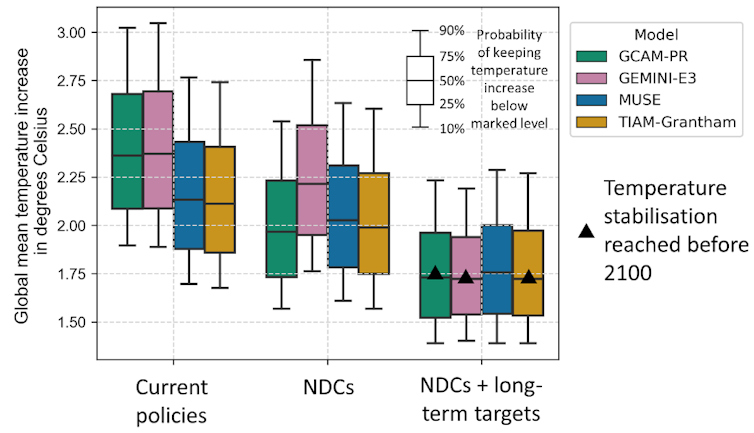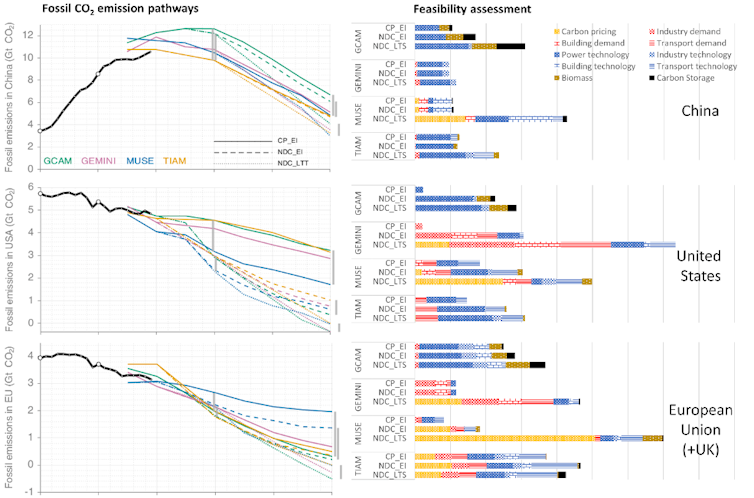
In the landmark Paris Agreement, adopted at the 2015 United Nations climate change conference (COP21), 196 countries decided that the world must limit global temperature increases to well below 2°C above pre-industrial levels – and to 1.5°C above current levels if possible.
Individual nations were to set national emissions targets with this overall goal in mind but, at the time, none were considered sufficient to realise a Paris Agreement-aligned future. Nonetheless, countries have since kept ramping up their emissions ambitions.
The COP26 talks in Glasgow in November 2021 saw considerable breakthroughs. More than 120 countries upgraded their 2030 targets. And, critically, major emitters representing over 70% of global CO₂ emissions announced or even adopted commitments to transitioning to climate-neutral economies.
Leading this race, both the European Union and the United States have committed to reducing their emissions to net zero (an overall balance between planet-warming greenhouse gas emissions produced and removed from the atmosphere) by 2050. Other top emitters have committed to later targets – China by 2060 and India by 2070.
Our new, comprehensive analysis published in Nature Climate Change suggests that, if fully implemented, these net-zero commitments could be enough to stabilise global warming to around 1.7-1.8°C within the century. This would likely be in the vicinity of the Paris Agreement’s “well below 2°C” target, even if 1.5°C would still remain out of reach.
Although this does sound like relatively good news, we also caution that achieving net-zero pledges in decades from now would involve turbocharging mitigation action today.
We evaluated to what extent energy and climate policies currently in the implementation or planning phase are aligned with 2030 and longer-term targets at the national level, and how attainable the decarbonisation trajectories are that are required to meet the pledged targets, in terms of the socioeconomic, technological, and physical challenges.
Our analysis of the impact of policies and pledges from the world’s leading economies explicitly suggests that delivering on their long-term promises requires decarbonisation efforts at unprecedented speed and scale.
A long list of boxes to tick
In projecting the temperature outcomes of policies currently in place, 2030 targets (Nationally Determined Contributions, or NDCs), and longer-term targets (including net-zero pledges), the study first breaks down the total climate action gap in three individual gaps:
An implementation gap, which captures the temperature difference between current policies and NDCs.
A long-term ratchet gap, which shows the temperature difference between NDCs and longer-term targets.
An ambition gap, which instead captures the difference between the temperature outcome of longer-term targets and the ultimate 1.5°C goal of the Paris Agreement.

The study finds that current ambition levels signalled through implemented policies are on track to increasing global temperatures to 2.1-2.4°C above pre-industrial levels by 2100, depending on the model used. Also, ambition levels stated in present NDCs slightly limit this increase to 2.0-2.2°C.
In both cases, warming is projected to continue after 2100, as global CO₂ emissions would not have yet reached net-zero levels by then. If countries also comply with their stated long-term goals after meeting their current NDC pledges in 2030, temperature increase could be further limited and stabilise around 1.7-1.8°C.
Taking into account the uncertainty in how emissions affect global temperatures, this translates to a 75% chance that global temperature increase stays below 2°C, arguably compatible with the “well-below 2°C” goal from the Paris Agreement.
We also perform deep dives into selected regions. For instance, we find that the USA and Japan have submitted ambitious NDCs, but at the same time their policies lag behind (the US Inflation Reduction Act was too recent to be included in this study), while countries such as China, India, and Russia display little ambition in their 2030 goals. As a frontrunner in climate efforts, the European Union is instead found to have ambitious policies already in place.

Walking the talk
Our analysis suggests there exist different “optimal” pathways towards net-zero, while each of these pathways would confront different hurdles and at different points of time between now and 2050.
For example, one route to net-zero could feature a significant challenge in ramping up diffusion of renewables to the required extent, while others appear to confront more challenges in terms of socioeconomic burdens. As expected, some paths to net-zero require – and therefore present dominant challenges in terms of – ramping up sustainable bioenergy supply and carbon capturing technologies.
What is interesting, though, is that different major economies are up against largely different challenges in delivering on their otherwise shared goal of holding average global temperature increase to well-below-2°C.
Indicatively, India and Japan are up against long-term bioenergy and carbon storage limitations in the long run, the United States would find it hard to achieve the necessary energy consumption cuts in the longer run, while the European Union should find ways to power-boost the deployment of clean tech within this decade.
This shows us that there really is no one-size-fits-all policy or technological approach to ensuring that the Paris Agreement goal is kept alive around the globe.

New grounds in the climate debate
A positive note is that climate action seems to bear fruit. In our previous similar study, two years ago, we had found a 2.3-2.7°C temperature increase as a result of current policies. That has decreased, implying climate policies have been dramatically strengthened in the past few years.
The more depressing finding though is that, while we no longer need to worry about governments’ low ambitions, we should probably start worrying about empty promises and shift away our focus from demanding bolder pledges. Evidently, ever since the COP26 Glasgow process, the most relevant factor to avoid a climate disaster is to secure the implementation of the existing country pledges.
Dirk-Jan van de Ven acknowledges financial support from the Spanish Ministry of Economic Affairs and Digital Transformation (Grant No. CEX2021-001201-M), the Horizon Europe European Commission Project IAM COMPACT, Grant No. 101056306, and via Horizon 2020 European Commission Project PARIS REINFORCE, Grant No. 820846.
Ajay Gambhir acknowledges funding received via UK Research and Innovation, Project 10045455, as part of the Horizon Europe European Commission Project IAM COMPACT, Grant No. 101056306, and via Horizon 2020 European Commission Project PARIS REINFORCE, Grant No. 820846.
Alexandros Nikas acknowledges funding from the European Union’s Horizon 2020 and Horizon Europe research and innovation programmes under Grant Agreement numbers 820846 (PARIS REINFORCE) and 101056306 (IAM COMPACT), respectively.
Shivika Mittal acknowledges funding received via UK Research and Innovation, Project 10045455, as part of the Horizon Europe European Commission Project IAM COMPACT, Grant No. 101056306, and via Horizon 2020 European Commission Project PARIS REINFORCE, Grant No. 820846
This article was originally published on The Conversation. Read the original article.







